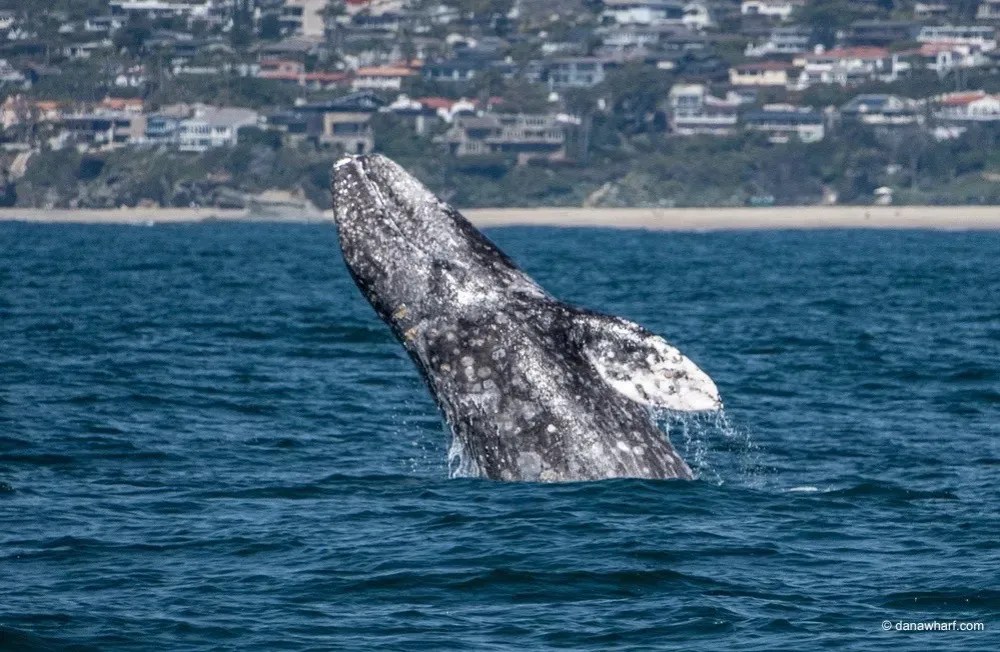Gray Whale vs. Humpback Whale: How to Tell the Difference on Your Dana Point Tour

You’re standing at the rail, scanning the ocean, when a massive tail fluke rises and slips beneath the waves—or maybe a full-body breach sends water flying. The excitement is real. But then someone asks: Was that a gray whale or a humpback?
At Dana Wharf, whale sightings are an everyday thrill, and one of the most common questions we hear on board is how to tell the difference between the two most frequently spotted species—gray whales and humpback whales. Whether you’re joining us for a winter migration cruise or a summer dolphin-and-whale combo tour, this guide will help you spot the difference like a pro.

Timing Is Everything
Gray whales and humpback whales both migrate along the Southern California coast—but at different times of year.
If you’re on one of our winter or early spring whale watching trips—especially from December to May—you’re most likely seeing gray whales. This is when they migrate from the icy waters of Alaska down to the warm lagoons of Baja California (and back again), often with calves in tow.
From late spring through fall, our tours regularly encounter humpback whales. They tend to stick around to feed in the nutrient-rich offshore waters near Dana Point during the summer and early fall.
Not sure which trip to book? Visit danawharf.com/whale-watching to explore current offerings and seasonal updates.
Size and Shape
Both whales are enormous—but they carry their size differently.
Gray whales grow up to 50 feet long and weigh 30-40 tons. They have a slim, streamlined body covered in barnacles and whale lice, which give them a distinctive mottled appearance.
Humpback whales are bulkier and can grow 50 feet or more in some cases. Their pectoral fins are unusually long—up to a third of their body length—and often appear white when seen from the side or below. If you spot a whale with large, curved flippers and a powerful arching back, it’s likely a humpback.
During our two-hour coastal cruises, our onboard naturalists help guests recognize these differences, often pointing out size, shape, and movement patterns in real time.
Behavior on the Surface
Humpbacks are the show-offs of the sea. They breach, slap their fins and tails, and even lunge-feed at the surface. On our summer and fall tours, it’s not uncommon to witness one launching completely out of the water.
Gray whales are more understated. They swim with calm, rhythmic movements and often travel in straight lines. While they sometimes breach or “spy hop,” it’s far less frequent.
So if you’re watching a whale that seems to be putting on a performance, chances are it’s a humpback. And if you’re watching a steady, gliding traveler? That’s a gray.
Book your next trip at danawharf.com/whale-watching to experience the difference firsthand.

Spouts, Fins, and Flukes
You can even tell whales apart by their spouts and dorsal fins.
Gray whales have a unique heart-shaped blow that splits slightly in the center. Instead of a dorsal fin, they have a low hump followed by a series of knuckles along their spine.
Humpbacks have a tall, bushy blow and a small, often curved dorsal fin set far back on their broad back.
If you’re lucky enough to see a tail fluke, that’s another strong clue. Gray whale flukes are narrower and often crusted with barnacles. Humpback flukes are wide and dramatically curved with distinct black-and-white patterns underneath—each one unique, like a fingerprint.
Our daily whale watching tours often include tail-fluke photo ops, and our captains and naturalists are experts at identifying individual humpbacks by their fluke markings.
What to Expect on a Dana Wharf Trip
Dana Wharf offers year-round whale watching tours departing from Dana Point Harbor. No matter when you go, there’s always a chance to see gray whales, humpbacks, fin whales, blue whales, common dolphins, bottlenose dolphins, sea lions, and more.
- Winter & Spring Trips: Prime gray whale season. Great for families and first-timers.
- Summer & Fall Trips: Ideal for spotting humpbacks and blue whales. Often includes dolphins by the hundreds.
- Private Charters: Want a more personal experience? Book a private whale watching trip with your own captain and crew.
You can view all tour options and availability at danawharf.com/whale-watching
Final Thoughts
There’s something unforgettable about seeing a whale in the wild—especially when you can name it. Gray or humpback, each has its own story, its own migration, and its own way of moving through the sea.
So next time you’re on a Dana Wharf whale watching tour, keep your eyes on the water—and your knowledge ready. Because when that next tail breaks the surface, you’ll know exactly what you’re looking at.
And if you’re still unsure? Just ask one of our onboard marine naturalists. We’re always happy to help you meet the ocean’s most incredible visitors—by name.
